Crafts bloom in places where there is an abundance of high-quality materials and embody a region’s local identity, culture, and history. In recent years, the rising interest in “locality” across the world has cast fresh light on crafts that are rooted in particular regions.
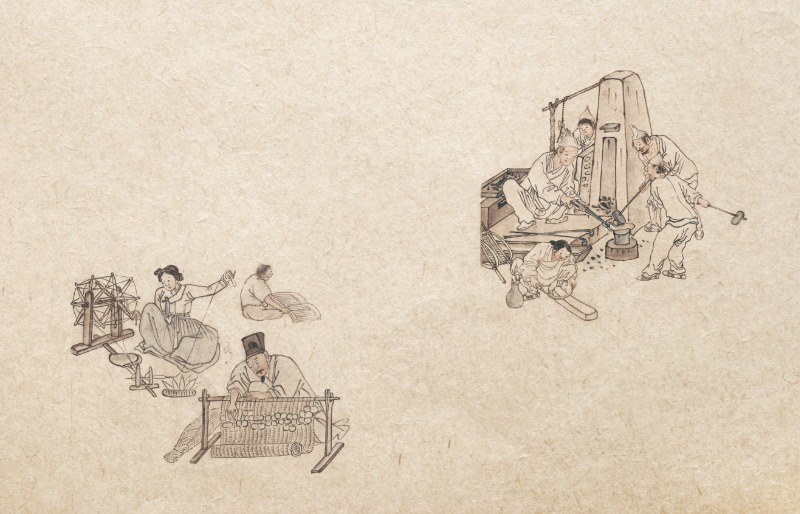
“Weaving a Mat” by Kim Hong-do. Late 18th century.
Ink and light color on paper. 28 × 23.9 cm.
In the painting, the young son reads a book out loud, the father weaves a mat, and the mother spins thread. During the Joseon Dynasty, craftwork was a livelihood.
© National Museum of Korea
“Forge” by Kim Hong-do. Late 18th century.
Ink and light color on paper. 27.9 × 24 cm.
The painting depicts blacksmiths working jovially, striking heated metal on an anvil. A forge is where all kinds of metal tools are made. These days, only a few remain in traditional markets in small rural towns.
© National Museum of Korea
The Encyclopedia of Women’s Daily Life (Gyuhap chongseo), written by Yi Bingheogak in the early 19th century, contains helpful information on housekeeping. A section of the book on famous regional craft products across the nation is a precious historical resource providing insight into the tastes of her contemporaries. Among the locales mentioned, some fell by the wayside during Korea’s modernization, but many retain their reputation to this day.
Handicraft traditions are invariably rooted in a particular region. As people settled down and built communities, they made necessary household items and shared them with others; in the process, they honed their skills and gained greater expertise. In traditional societies, products were generally made with materials that were easily obtained in the surrounding environment. Some prominent examples are f lower-patterned woven mats from Ganghwa Island, ramie from the Hansan region, bamboo ware from Damyang County, and mother-of-pearl lacquerware from Tongyeong. Craft masterpieces are usually associated with the areas where the materials are sourced, and handicrafts recognized as outstanding works of art are often mentioned in one breath with the regions where the materials are produced.
Community Effort
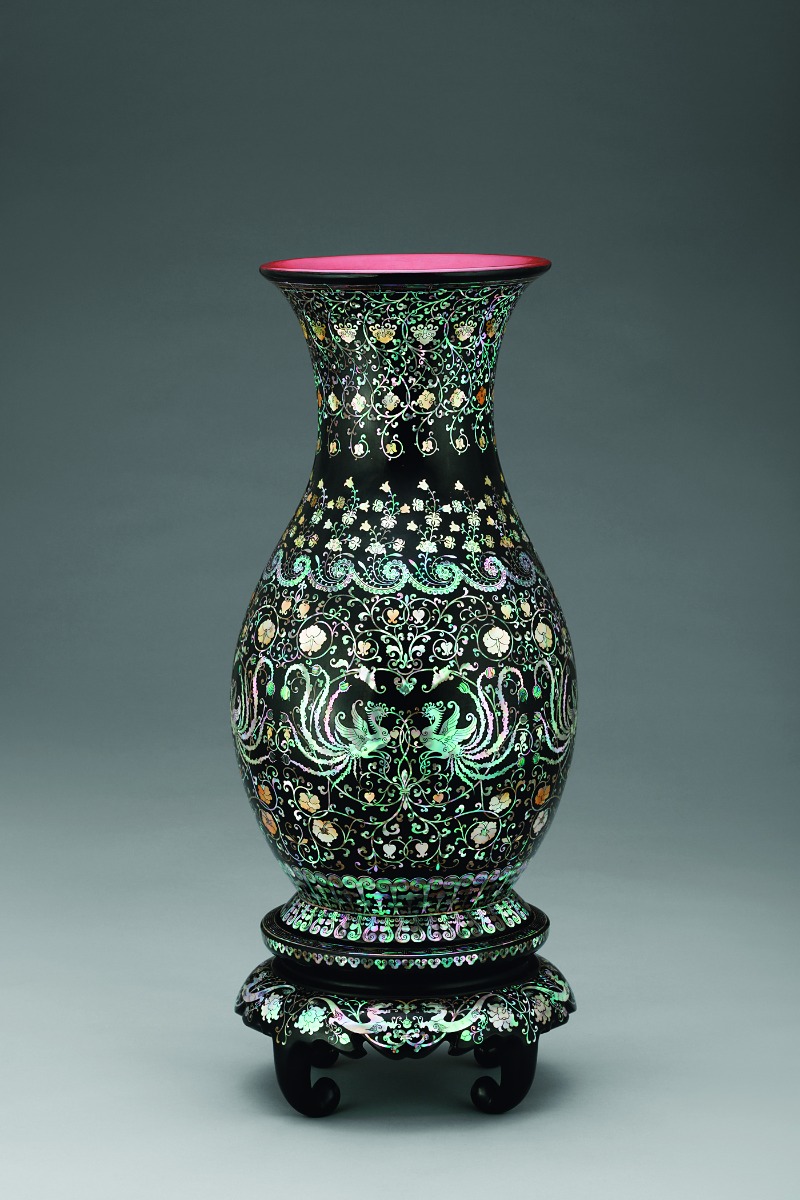
“Earthenware Vase with Phoenix and Scroll Design Inlaid with Mother-of-pearl” by Kim Bong-ryong. 1930s.
Mouth D: 27 cm, Body D: 27 cm, H: 61 cm.
Earthenware vase coated with lacquer and ornately decorated with phoenix, Rose of Sharon, and scroll designs. It received a prize at the Joseon Art Exhibition in 1936. Kim Bong-ryong, a native of Tongyeong, is known for his bold nacre lacquerware that builds on the traditions of the Joseon Dynasty. In 1966, he was designated as the first title holder of the art of nacre lacquerware, a National Intangible Cultural Heritage.
© Wonju Museum of History
Tongyeong is a city on Korea’s southern coast boasting a plentiful supply of abalone with vivid, beautifully patterned shells, the result of weathering rough currents. The processed shells are used to make najeon chilgi (lacquerware inlaid with mother-of-pearl), which the city is famous for. Its nacre lacquerware products are beloved works of art and craft that have endured much change over the centuries. The tradition has been kept alive thanks to the devotion of artisans and their solidarity through the ages.
Tongyeong is where the Korean naval forces were based during the Imjin War, which saw Korea fend off two Japanese invasions between 1592 and 1598. The naval commander leading the battles was Admiral Yi Sun-shin (1545–1598), famous for designing the turtle ship that led Korea to victory. This historical background played a large part in the city’s fame as home to the magnificent nacre craft. During this period, workshops were systematically operated for the first time with skilled artisans recruited to make military supplies and household items. Thereafter, the number of workshops continued to increase, giving rise to the phrase “12 workshops of Tongyeong,” referring to the city’s thriving craft industry and numerous workshops that sprouted up there.
Producing a piece of nacre lacquerware is an elaborate endeavor. The numerous processes require the collaboration of several artisans who work and live nearby: the somokjang makes the wooden , the chiljang coats it with lacquer, the duseokjang makes the metal fittings, and the najeonjang inlays designs with finely filed abalone shells. To this day, Tongyeong’s artisans live in close proximity like family.
In Seocheon, South Chungcheong Province, there are eight villages that are the largest producers of ramie in Korea, collectively known as jeosan pareup. Likewise, the eight towns in the Nakdong River area known for their woven reed mats are called seoksan pareup. The reputation of such places associated with particular products is not owing to one or two skilled artisans but rather the collaborative effort of an entire community involved in their production and distribution. For instance, to make a single hapjukseon (bamboo folding fan), several workshops need to work closely together. The processes are all separated — splitting the bamboo, thinning the pieces down and gluing two strips together to make the fan ribs, folding and pasting hanji (traditional mulberry paper) onto the ribs, burning patterns into the wood with a heated iron, and carving an ornament for the handle — to enhance work efficiency and the quality of the product.
Geographical Advantage
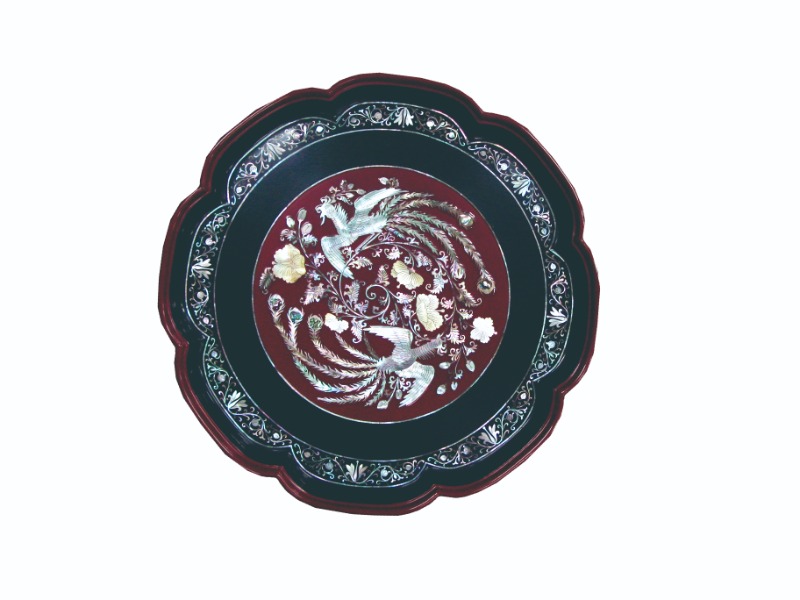
“Dish with Two Phoenixes and Lotus Leaf Design Inlaid with Mother-of-pearl” by Kim Bong-ryong. After 1945. 40 × 40 cm.
Kim established craft workshops in Tongyeong and Wonju where he trained many craftsmen.
Tongyeong is famous for its superior quality mother-of-pearl and Wonju for its lacquer tree sap, the two most important materials of nacre craft.
© Wonju Museum of History
, or brassware, is particularly useful in the winter months as it can keep food warm for a long time. A brass bowl of rice placed on a heated
ondol floor and covered with a blanket is too hot to touch even after a few hours. Valued for its durability and golden luster, brassware came into wide use from the 18th century, even among commoners, and the production skills spread nationwide. The two regions most noted for high-quality brassware are Anseong in Gyeonggi Province, South Korea, and Napchong in North Pyongan Province, North Korea, which both functioned as key distribution hubs on the way to the capital.
Located close to Seoul, Anseong built its reputation by supplying brassware to noble families in the capital. Anseong yugi is made by pouring molten brass into a mold. The Korean idiom
anseong matchum, referring to the perfect solution for a particular situation or condition, is derived from the merits of Anseong brassware, which is tailor-made for customer needs and supplied without a glitch.
Napchong brassware is produced with the hand forging technique called bangjja. Artisans stand in a circle and with hammers of varied sizes strike heated metal on an anvil to shape it. Handling the red hot metal takes great skill, and those involved develop strong bonds and share great pride in their work. Musical instruments like the jing (large gong) and the kkwaenggwari (small gong) must be made with the bangjja technique to produce the right sound. The work is usually done during the quiet of the night to ensure better sound quality.
Namwon in North Jeolla Province, where there is a plentiful supply of wood from Mt. Jiri, is known for its woodcraft. Here, wooden wares are carved on a lathe, a machine tool on which the workpiece is rotated. This is an effective way of making tableware and utensils for ancestral rites as well as bowls for washing rice. The lathe is featured in Joseon Dynasty genre paintings that offer a glimpse of traditional woodwork. In Namwon, traditional lathe techniques have been passed down to the present.
In regions that are famous for a particular handicraft tradition, master artisans honed their skills as they both competed and collaborated with one another. Their craft was passed down from generation to generation through apprentices, and Korea’s intangible cultural heritage has been preserved through this training system. In 1962, the government enacted the Cultural Heritage Protection Act, providing a policy framework for the preservation of intangible skills and practices.
Revitalizing the Rural Ecosystem
The “locality” of crafts takes on new meaning in contemporary times. Since the modern era, culture has flourished mostly in urban areas, while rural regions are on the path of decline. Locality, meaning “local or regional character,” has recently emerged as a subject of discourse as the decline of rural areas accelerates. At such a time, fresh light has been cast on crafts as an effective means of revitalizing rural areas and ensuring their future. This is a phenomenon not confined to Korea but unfolding across the world. While young creators can draw inspiration from local crafts, local artisans can seek new paths by reinterpreting their expertise and skills.
Expertly produced handicrafts can be an alternative to goods that are mass-produced and consumed, and a solution to the ensuing problems in contemporary society. Growing interest among the younger generation in cultural content with a unique local flavor can help revive local crafts. In turn, answers to reviving local areas may be found in the expertise of skilled artisans and traditional craft practices.
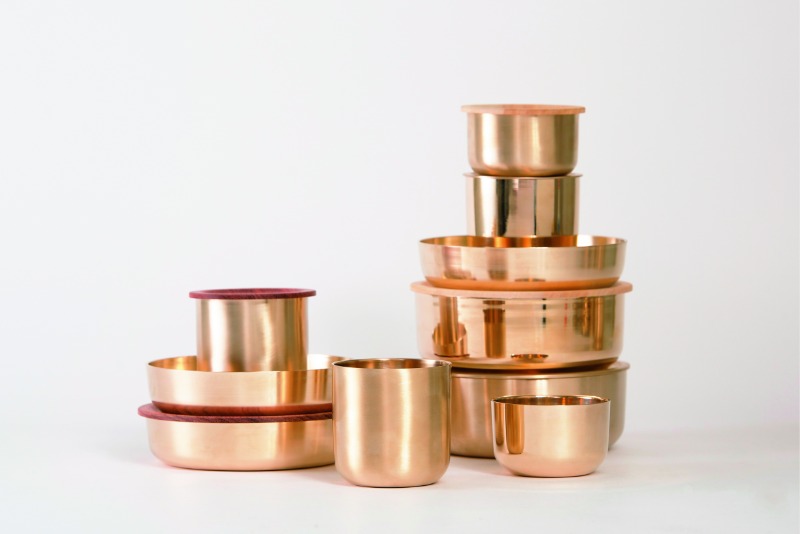
Brassware produced in collaboration by Kim Soo-young and Gio Ki-sang through the YÉOL Project. Kim, designated as yugijang, title holder of the art of brassware making, a National Intangible Cultural Heritage, carries on the tradition of Anseong brassware. He also collaborates with young designers to produce works with a modern touch.
Courtesy of YÉOL
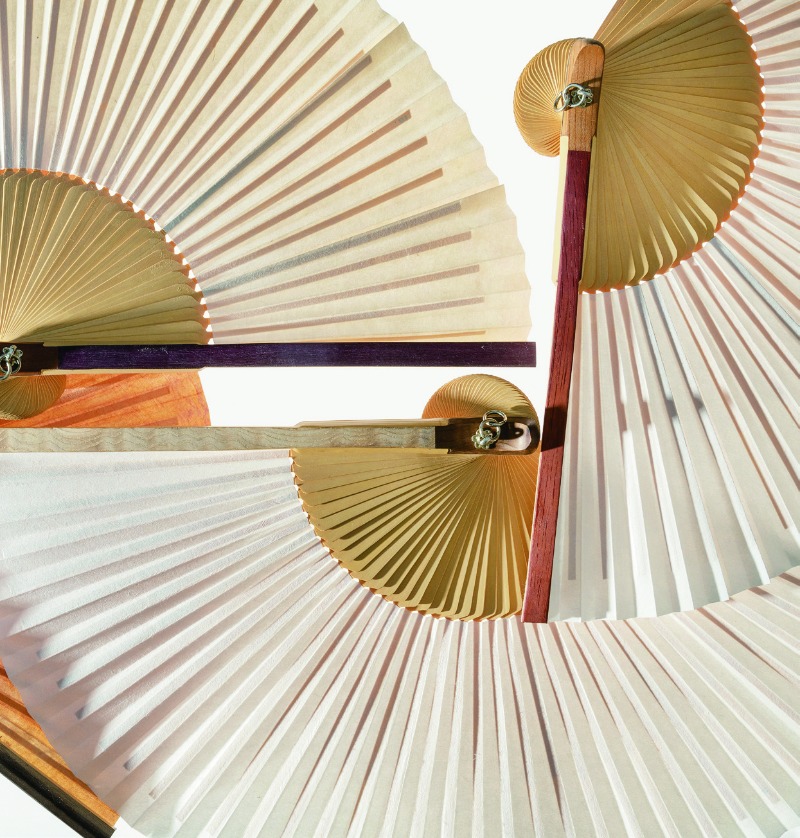
Folding fan made by certified trainee Kim Dae-sung when he participated in the Creativity Workshop residency run by the National Intangible Heritage Center in 2021. Following his father, he is the fifth-generation member of his family to carry on the tradition of fan making in Jeonju.
Courtesy of National Intangible Heritage Center, Photo by Seo Heun-kang
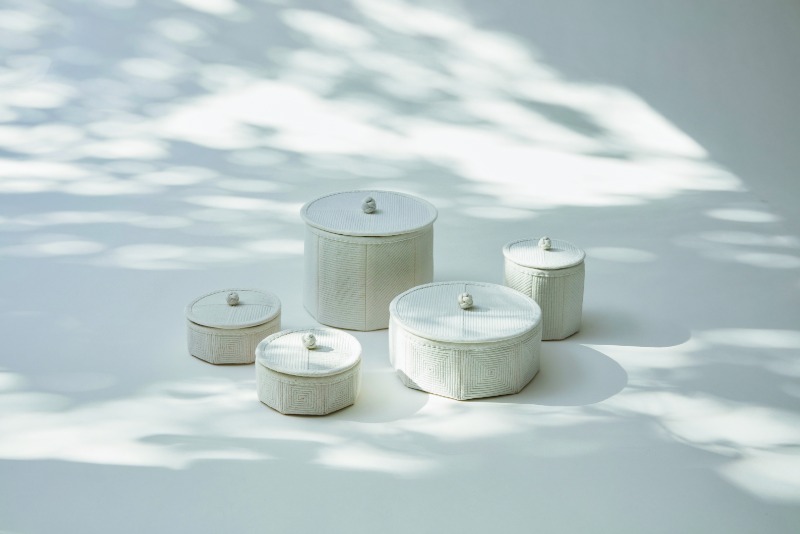
Quilted cotton box by artisan Park Gyeong-hyi, the second-generation member of her family to carry on the Tongyeong nubi (quilting) craft. She succeeds the tradition of Tongyeong quilting using the Chinese character “亞” as a pattern in her works.
Courtesy of Korea Craft & Design Foundation
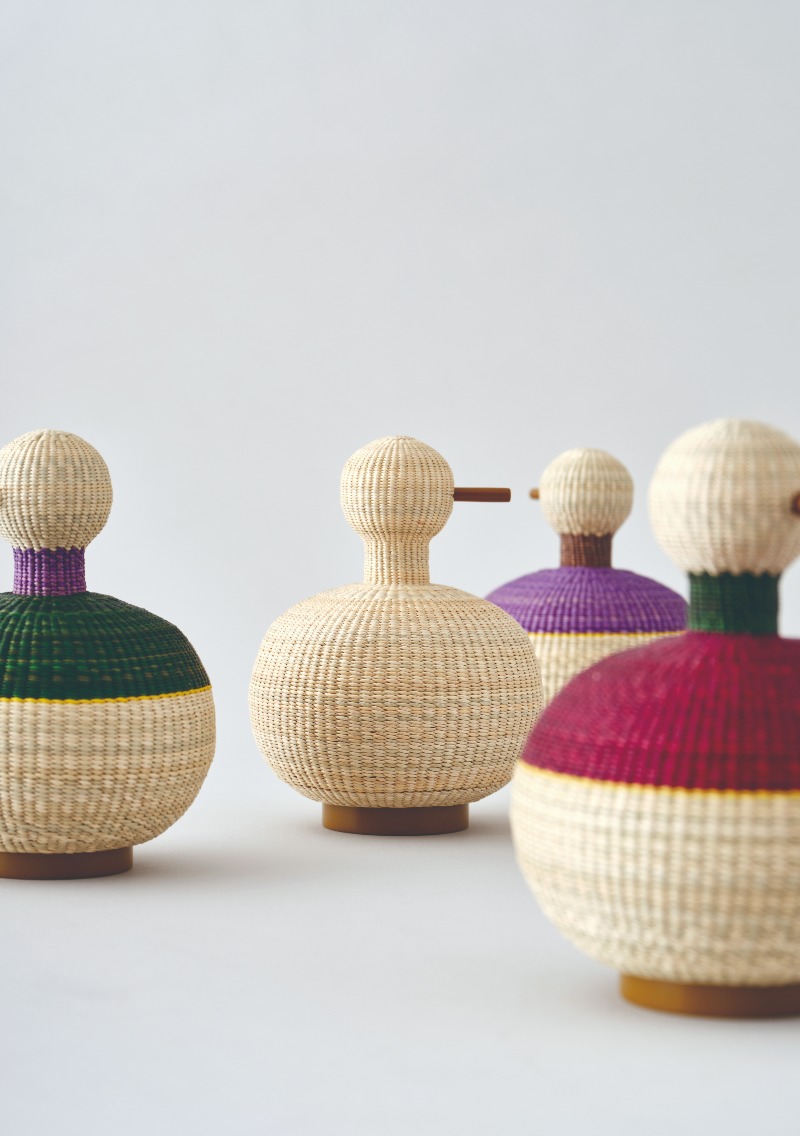
Sedge weaving flourished on Ganghwa Island. Pictured are wild goose sedge boxes produced in collaboration between artisan Huh Sung-ja, certified trainee of the craft, and Studio Word.
Courtesy of Korea Craft & Design Foundation
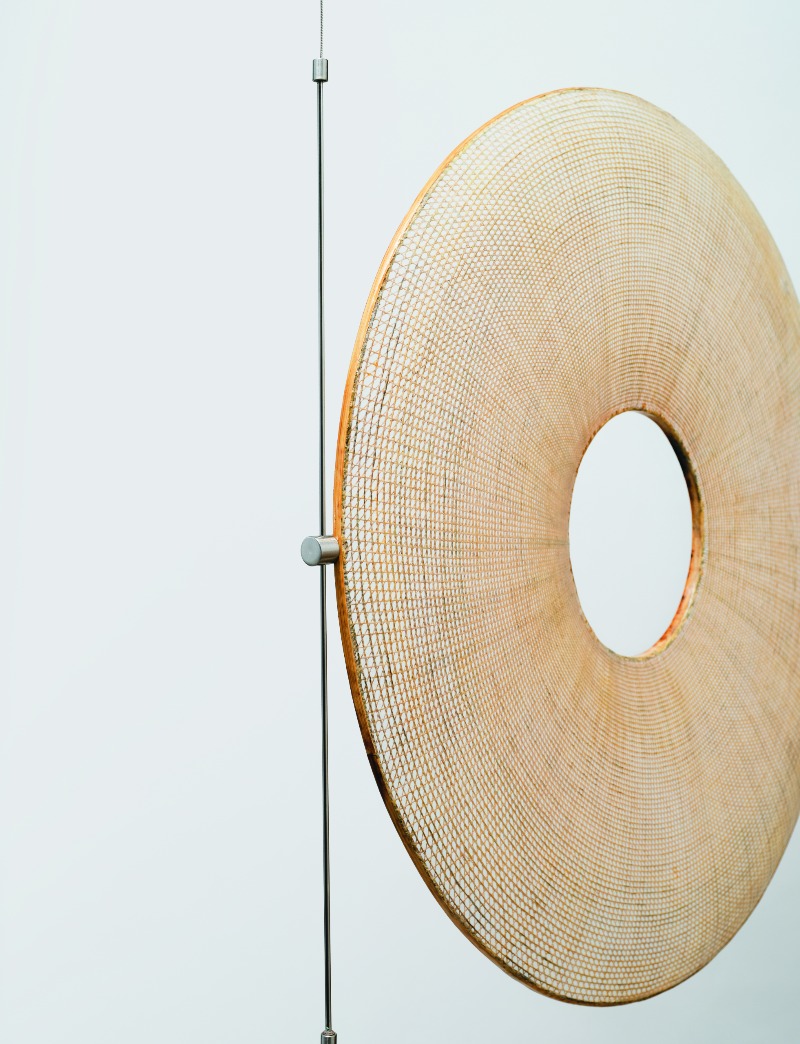
Pendant light produced in collaboration between master artisan Jeong Chun-mo, designated as ipjajang, title holder of the art of gat making, a National Intangible Cultural Heritage, and Studio Word. The tradition of making gat (traditional horsehair hat) has been passed down largely in Tongyeong and on Jeju Island.
Courtesy of Studio Word
Choi Gong-hoCraft Historian